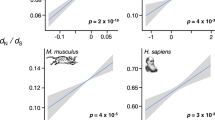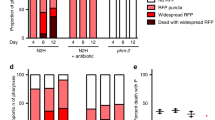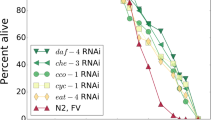Abstract
It was proposed almost 50 years ago that ageing is non-adaptive and is the consequence of a decline in the force of natural selection with age1. This led to the theory that ageing results from detrimental effects late in life of genes that act beneficially in early life1,2, so any genetic alteration that increases lifespan might be expected to reduce fitness, for example. We show here that a mutation that greatly increases the lifespan of the nematode Caenorhabditis elegans does indeed exhibit a fitness cost, as demonstrated during starvation cycles that may mimic field conditions, thereby validating the pleiotropy theory of ageing2.
This is a preview of subscription content, access via your institution
Access options
Subscribe to this journal
Receive 51 print issues and online access
$199.00 per year
only $3.90 per issue
Buy this article
- Purchase on Springer Link
- Instant access to full article PDF
Prices may be subject to local taxes which are calculated during checkout

Similar content being viewed by others
References
Medawar, P. B. An Unsolved Problem of Biology (Lewis, London, 1952 ).
Williams, G. C. Evolution 11, 398–411 ( 1957).
Morris, J. Z., Tissenbaum, H. A. & Ruvkun, G. Nature 382, 536– 539 (1996).
Friedman, D. B. & Johnson, T. E. J. Gerontol. 43, B102–B109 ( 1988).
Malone, E. A., Inoue, T. & Thomas, J. H. Genetics 143, 1193– 1205 (1996).
Tissenbaum, H. A. & Ruvkun, G. Genetics 148, 703–717 (1998).
Kenyon, C. et al. Nature 366, 461–464 (1993).
Lithgow, G. J., White, T. M., Melov, S. & Johnson, T. E. Proc. Natl Acad. Sci. USA 92, 7540–7544 (1995).
Duhon, S. A. & Johnson, T. E. J. Gerontol. Biol. Sci. Med. Sci. 50, B254–B261 ( 1995).
Lithgow, G. J., White, T. M., Hinerfeld, D. A. & Johnson, T. E. J. Gerontol. 49, B270–B276 (1994).
Author information
Authors and Affiliations
Corresponding author
Rights and permissions
About this article
Cite this article
Walker, D., McColl, G., Jenkins, N. et al. Evolution of lifespan in C. elegans . Nature 405, 296–297 (2000). https://doi.org/10.1038/35012693
Issue Date:
DOI: https://doi.org/10.1038/35012693
This article is cited by
-
Caenorhabditis elegans foraging patterns follow a simple rule of thumb
Communications Biology (2023)
-
Small flexible automated system for monitoring Caenorhabditis elegans lifespan based on active vision and image processing techniques
Scientific Reports (2021)
-
University of Southern California and buck institute nathan shock center: multidimensional models of aging
GeroScience (2021)
-
Unexpected cell type-dependent effects of autophagy on polyglutamine aggregation revealed by natural genetic variation in C. elegans
BMC Biology (2020)
-
Improving lifespan automation for Caenorhabditis elegans by using image processing and a post-processing adaptive data filter
Scientific Reports (2020)
Comments
By submitting a comment you agree to abide by our Terms and Community Guidelines. If you find something abusive or that does not comply with our terms or guidelines please flag it as inappropriate.



